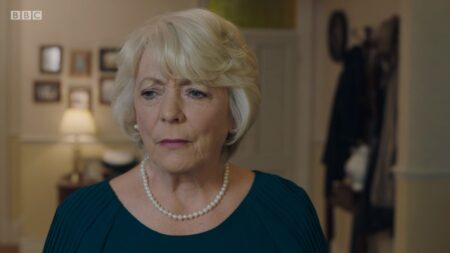Last week, a number of UK TV executives discussed strategies for programming television, particularly at this time, during the pandemic, during the BBC’s Digital Cities Virtual Events. And pretty much all came to the same conclusions: that what audiences want, right now, is warm-hearted, comfort-television. This is also the conclusion that I had come to that could explain my utter addiction to Gardener’s World (BBC, since 1968) and Beechgrove (BBC Scotland, since 1978). Both of these programmes have done very well during lockdown – with Beechgrove managing to amass figures that made it the most popular programme on BBC Scotland in some weeks (of ca. 180,000 see BARB, 2020), whilst Gardener’s World managed to hold on to approx. 3.5 million viewers most weeks, despite constantly changing time slots. Similarly, Cathy Johnson commented on a data visualisation of JP Kelly’s third year students’ Netflix consumption that it seemed to make visible how much of this was comfort television.
So, we are all watching a lot of comfort television. But are we feeling comfortable? I am asking because what struck me the other day was that I felt a serious sense of disappointment when I watched something that was light hearted and indeed made light of the pandemic, namely the anthology dramas of Unprecedented (BBC, 2020). Like Staged (BBC, 2020), it used the Zoom aesthetic that we all have gotten used to over the lockdown. As Orit Gat (2020) highlights, such an aesthetic is marked by an element of flatness, revolves around the safe and wholesome and around the home – not unlike The Brady Bunch (ABC, 1969-1974). But unlike Staged, Unprecedented attempted to tell stories of everyday people and how they lived their lives. It had some amazing actors in it, but it still disappointed, and that was largely because it told serious stories only to make light of them. There is, for example, the story of a mother (Sue Johnston) who had lost her husband just shortly before the pandemic and whose three daughters (Denise Gough, Rochenda Sandall and Rebekah Staton) are trying to get her to open up about how she was (‘fine’). When she finally admits to her true feelings, the daughters cannot cope with it and return to descriptions of food that had dominated the conversations before, only for the mother to zoom out. Although several of the stories were darker (there was one on domestic violence, one derived from the words of current NHS and care staff, whilst another spoke about the human impact on climate change from the point of view of bats), most of the stories turned towards the comedic and/or happy at the end. It didn’t feel right.
So, I decided to observe myself a bit further. What was it actually that made me crave the programmes that I ended up watching? More recently, I noticed they have had a shared theme: grief. Beginning with the astounding Life (BBC, 2020), over to 24 Hours in A&E (Channel 4, since 2011), 999 What’s Your Emergency (Channel 4, since 2012), Ambulance (BBC, since 2016), DIY SOS (BBC, since 1999) and The Green Hollow (BBC Wales, 2016), they all include moments of grief, and it is those moments that I have dwelt on. Let’s start with Life, a programme that combines a number of human experiences, including becoming a parent, falling in love, falling out of love, and dealing with death. It’s the latter – dealt with over two stories – that drew me in, potentially also because of the incredible acting of Alison Steadman and Adrian Lester. Both are incredibly subtle in their performances, but both make use both of their bodies and their faces, while the camera frames them in long shots and close-ups to convey the sense of despair they feel. But their emotional range is broader than simple despair or even grief; there are feelings of hopelessness and being at a loss at what to do. Here are people feeling the worst feelings, and here I am watching and crying.

Fig. 1: Examples from Life (episode 1 and episode 4) that shows the range of bodily expression used by Alison Steadman …
Watching them, I understand the feelings although mine come from somewhere else. And it is good to see them reflected. Similarly, I dwell on the stories of loss in the medical documentaries and in DIY SOS. Here, the simple remembrance cards at the end of Ambulance, for example, and the family members speaking about their loved ones in 24 Hours in A&E make me choke up, but also honour those lost, despite never having met them myself. Of course, there are also the uplifting stories, and seeing those honoured by family members emphasises the positive impact people have had. But is the experience of grief that I feel an emotional affinity to.
David Lavery wrote about his experiences of crying in response to television, and his original post led to the publication of On the Verge of Tears (with Byers, 2010). Lavery’s main aim in the original blog was to get the conversation going, and despite their book, this still seems necessary. Whilst the authors in the book explore a number of reasons for their emotional responses, a time like ours – in which a global pandemic combines with the rise of far-right politics in several countries in the world – offers us the opportunity to reflect on emotion and tears not just as personal, but as historic-cultural. Indeed, as, on the northern hemisphere, the pandemic summer is replaced by a second wave autumn, whilst US Americans queue for hours to cast their votes, my turn to grief is perhaps also enhanced or triggered by the gradual dying off of nature around me and a slight sense of ending elsewhere (a feeling obviously also pointed to by others, including in broader ways in relation to changing paradigms more generally). Of course, it is interesting at this point to return to Williams (1977) in particular precisely because he emphasised our affective responses in order to make sense of the processes of change.
Misha Kavka (2008: 5) argues ‘for the affective productivity of televisual presence, which makes of “social integration” a community of engagement’, thus highlighting precisely that the experience of emotional affect as a result of watching television is also social. When speaking about the public mourning for Princess Diana, Kavka emphasises the communal experience that the mediation of the public outpouring of grief enabled (37-45). Looking not just at reception but also at production, Kristyn Gorton indicates (2009: 61), drawing on Sarah Ahmed, that television takes part in the circulation of emotion, though not every viewer will respond to these emotions in the same way. Thus, television, perhaps, also ‘catches’, to use their word, the emotion prevailing at any one time and recirculates this to a more or less receptive audience. Of course, for TV drama, this process of ‘catching’ involves a significant delay, and even documentaries usually take years in development and production, even though, as the above mentioned Covid dramas Staged and Unprecedented make clear, there is a wish to respond with fresh drama right here and right now. But it is perhaps not necessary for television to do anything at all – to try and deliver the uplifting stories that the executives thought we all needed and wanted. But rather it is us, and how we respond to television – to stories that are both uplifting and heart-breaking as all of the above mentioned are – that matters.
As television scholars, then, we can perhaps add to the executives understanding of the big data by drilling down and looking further: by asking ourselves and those that we study: what is our emotional response? Are we transitioning from one emotional state to another? And is it time to grieve yet?
Elke Weissmann is Reader in Film and Television at Edge Hill University. She is currently considering changing this to Reader in Television and Film, however. Her books include Transnational Television Drama (Palgrave) and the edited collection Renewing Feminisms (I.B.Tauris) with Helen Thornham. She sits on the board of editors for Critical Studies in Television. She migrated to the UK in 2002 after realising that German television was as bad as she remembered.
Acknowledgement
With my usual thanks to David L. Palatinus who as always offered his own insights in the development of the blog and suggested some further reading.






